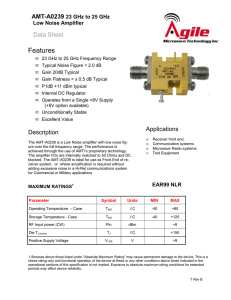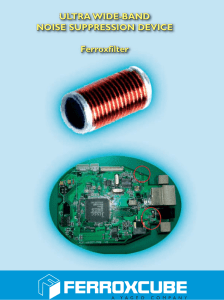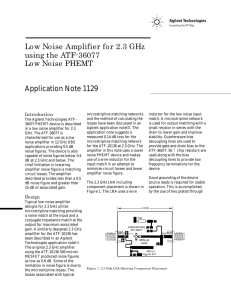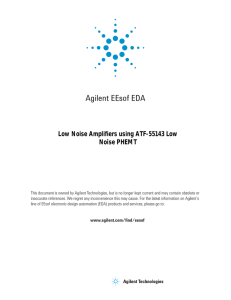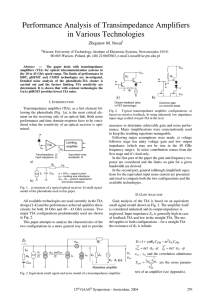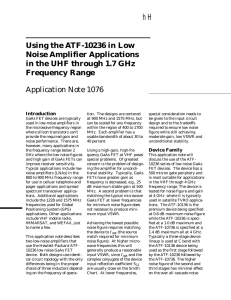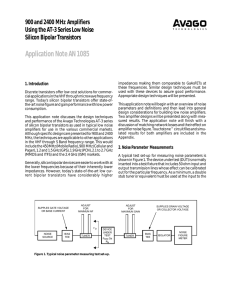Low Noise Amplifier for 5.7 GHz using the ATF - SP
advertisement
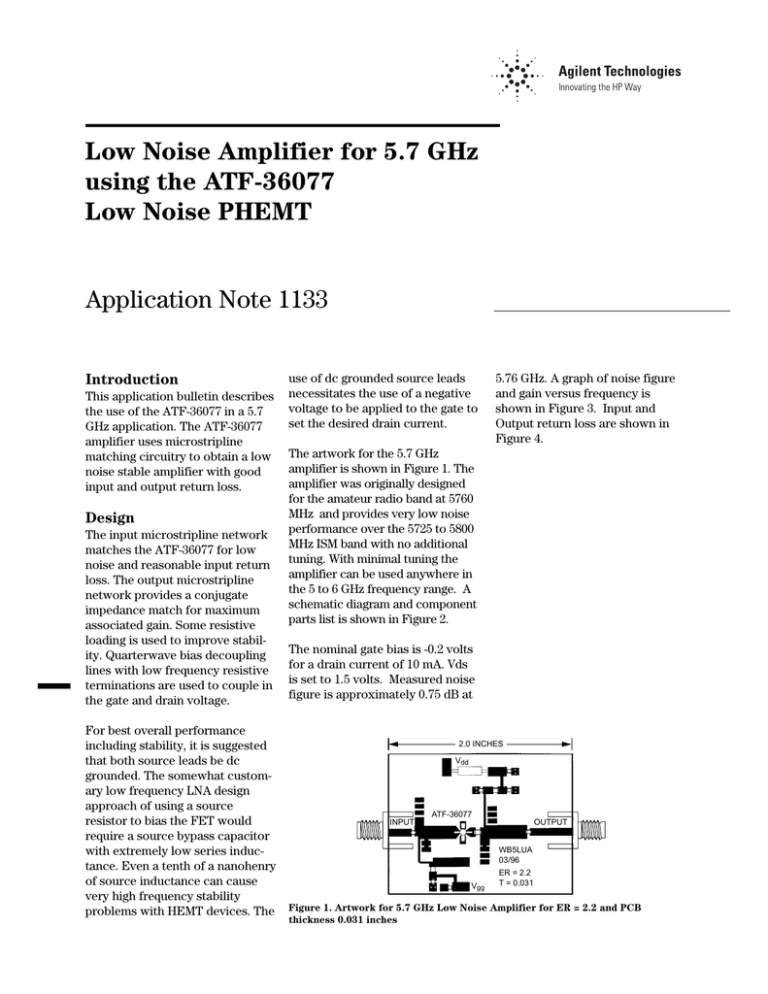
Low Noise Amplifier for 5.7 GHz using the ATF-36077 Low Noise PHEMT Application Note 1133 Introduction This application bulletin describes the use of the ATF-36077 in a 5.7 GHz application. The ATF-36077 amplifier uses microstripline matching circuitry to obtain a low noise stable amplifier with good input and output return loss. Design The input microstripline network matches the ATF-36077 for low noise and reasonable input return loss. The output microstripline network provides a conjugate impedance match for maximum associated gain. Some resistive loading is used to improve stability. Quarterwave bias decoupling lines with low frequency resistive terminations are used to couple in the gate and drain voltage. For best overall performance including stability, it is suggested that both source leads be dc grounded. The somewhat customary low frequency LNA design approach of using a source resistor to bias the FET would require a source bypass capacitor with extremely low series inductance. Even a tenth of a nanohenry of source inductance can cause very high frequency stability problems with HEMT devices. The use of dc grounded source leads necessitates the use of a negative voltage to be applied to the gate to set the desired drain current. 5.76 GHz. A graph of noise figure and gain versus frequency is shown in Figure 3. Input and Output return loss are shown in Figure 4. The artwork for the 5.7 GHz amplifier is shown in Figure 1. The amplifier was originally designed for the amateur radio band at 5760 MHz and provides very low noise performance over the 5725 to 5800 MHz ISM band with no additional tuning. With minimal tuning the amplifier can be used anywhere in the 5 to 6 GHz frequency range. A schematic diagram and component parts list is shown in Figure 2. The nominal gate bias is -0.2 volts for a drain current of 10 mA. Vds is set to 1.5 volts. Measured noise figure is approximately 0.75 dB at 2.0 INCHES Vdd INPUT ATF-36077 OUTPUT WB5LUA 03/96 Vgg ER = 2.2 T = 0.031 Figure 1. Artwork for 5.7 GHz Low Noise Amplifier for ER = 2.2 and PCB thickness 0.031 inches INPUT Q1 C1 C2 R3 OUTPUT 0 -2 R2 R1 R4 Vdd Vgg C4 C5 C3 RETURN LOSS (dB) -4 -6 INPUT -8 -10 -12 -14 OUTPUT -16 PARTS LIST C1 1 pF CHIP CAPACITOR (1 TO 2 pF OK) C2 1 pF CHIP CAPACITOR (1 TO 2 pF OK) C3, C5 1000 pF // 0.01 µF CHIP CAPACITOR IN PARALLEL C4 22 pF CHIP CAPACITOR Q1 AGILENT TECHNOLOGIES ATF-36077 PHEMT R1, R2 50 OHM CHIP RESISTOR R3 10-27 OHM CHIP RESISTOR (EFFECTS GAIN/STABILITY) HIGHER R = LOWER GAIN AND BETTER STABILITY R4 FOR OPERATION FROM A POWER SUPPLY VOLTAGE OF 5 VOLTS, R4 = 200 OHMS - R3 - R2 -18 5 5.1 5.2 5.3 5.4 5.5 5.6 5.7 5.8 5.9 6.0 FREQUENCY (MHz) Figure 4. Input and Output Return Loss Figure 2. 5.7 GHz Low Noise Amplifier Schematic Diagram Freq. (MHz) Gain (dB) Noise Figure (dB) 5000 5050 5100 5150 5200 5250 5300 5350 5400 5450 5500 5550 5600 5650 5700 5750 5800 5850 5900 5950 6000 13.2 13.4 13.6 13.7 13.8 13.8 13.8 13.7 13.6 13.4 13.2 13.1 12.9 12.7 12.6 12.3 12.1 11.6 11.4 11.1 10.6 1.10 1.06 1.02 0.99 0.96 0.92 0.90 0.86 0.83 0.82 0.79 0.79 0.78 0.76 0.76 0.75 0.77 0.78 0.80 0.81 0.86 Figure 3. Gain and Noise Figure www.semiconductor.agilent.com Data subject to change. Copyright © 1999 Agilent Technologies, Inc. 5966-1277E (11/99)
